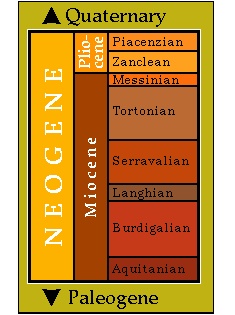







The Miocene was first recognized and defined by Charles Lyell in the early nineteenth century. While examining rocks in the Paris Basin, he noted that different strata contained varying percentages of living mollusc species. The Miocene consisted of layers in which only 18% of the fossils were represented among living mollusc species.
Stratigraphy within the Miocene, as with much of the Cenozoic, is often defined on a highly regional basis. Terrestrial faunas are recognized in ages which vary from continent to continent, primarily because the animals themselves varied from place to place. These ages are usually defined on the basis of the land mammals, so that North America, Europe, Australia, etc. each have their own Land Mammal Ages.
For marine stratigraphy, diatoms and foraminifera are the primary groups used to recognize ages. By this time, both groups were abundant and diversified globally, so much so that diatomite is a common marine sediment of the Miocene. Because the diatoms are abundant, and are the substance of which many marine deposits are formed, they are particularly useful for identifying the relative ages of fossil deposits.
 |
Miocene: The chart at left shows the major subdivisions of the Neogene, the last portion of the Tertiary Period, including the Miocene. You may click anywhere on the other Epoch (Pliocene) or the arrows to navigate to those exhibits. The Miocene Epoch is part of the Cenozoic Era. |
Find out more about the Tertiary paleontology and geology of North America at the Paleontology Portal.


